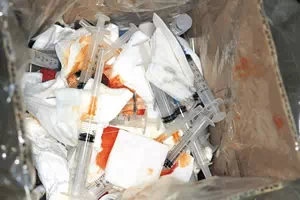Dental Offices Solid Wastes - Hazardous Waste
 Hazardous wastes are regulated under the federal Resource Conservation and Recovery Act or similar state regulations. These rules require all businesses, including dental offices, to determine if the wastes they generate are hazardous or not, and if they are hazardous, to follow specific procedures for managing and disposing of the wastes.
Hazardous wastes are regulated under the federal Resource Conservation and Recovery Act or similar state regulations. These rules require all businesses, including dental offices, to determine if the wastes they generate are hazardous or not, and if they are hazardous, to follow specific procedures for managing and disposing of the wastes.
To regulate the over 800,000 hazardous waste generators in the U.S., EPA established three categories of generators:
- Very Small Quantity Generators (VSQG) who generate less than 100 kg of non-acute hazardous waste a month, less than 1 kg of acute hazardous waste a month (e.g., p-listed wastes such as epinephrine) and less than 100 kg of residues or contaminated soil, waste, and other debris from the spill cleanup of acute hazardous waste.
- Small Quantity Generators (SQG) who generate between 100 kg and 1,000 kg of non-acute hazardous waste a month, less than 1 kg of acute hazardous waste a month, and less than 100 kg of spill residue from acute hazardous waste.
- Large Quantity Generators (LQG) who generate 1,000 kg or more of non-acute hazardous waste a month, 1 kg or more of acute hazardous waste a month, and 100 kg or more of spill residue from acute hazardous waste.
Nearly all dental offices meet the definition of very small quantity generators (an exception might be a dental office that is associated with a larger facility, such as a university). However, some states do not recognize the VSQG category. As a result, in those states, dental offices will likely be regulated as a small quantity generator (SQG). An SQG must meet additional requirements related to tracking of and accountability for the waste. Further, some states have a VSQG category, but they require VSQGs to follow some of the SQG requirements, such as obtaining an EPA identification number, or complying with storage standards. You can investigate your state requirements using this EPA hazardous waste generator categories table.
VSQGs often mistakenly assume that because they are partly exempt, their hazardous wastes are not subject to regulation. This is not entirely correct. The hazardous wastes generated by a VSQG are still considered hazardous wastes. They are not excluded from regulation but are subject to the reduced management requirements applicable to VSQGs. For VSQGs, there are three basic hazardous waste management requirements:
1. You must identify all hazardous waste generated by your business. Any solid waste (which may be a solid, sludge, liquid, or contained gas; and is any spent, used, discarded, abandoned, or no longer useable material) generated by your business must be evaluated to determine if it is a hazardous waste, either listed or by a hazardous waste characteristic. For more information, see: HERC's Hazardous Waste Determination.
2. You may not store more than 1,000 kg (2,200 lbs) of hazardous waste or 1 kg (2.2 lbs) of acute hazardous waste on site at any time.
3. You must ensure delivery of your hazardous waste to an off-site treatment or disposal facility that is one of the following (or if you treat or dispose of your hazardous waste on site, your facility also must be):
- A state or federally regulated hazardous waste treatment, storage, or disposal facility (TSDF). • A facility permitted, licensed, or registered by a state to manage municipal or industrial solid waste.
- A facility that uses, reuses, or legitimately recycles the waste (or treats the waste prior to use, reuse, or recycling).
- A universal waste handler or destination facility subject to the universal waste requirements of 40 CFR Part 273. Universal wastes are hazardous wastes such as batteries, recalled and collected pesticides, mercury-containing thermostats and other equipment, mercury-containing lamps, or aerosol cans.
4. Registration, manifests and recordkeeping. VSQGs are not required to have an EPA ID number or use the Uniform Hazardous Waste Manifest when shipping waste offsite. There is no time limit on how long VSQGs may accumulate hazardous waste. However, they may never exceed the 1,000 kg maximum quantity limit, and the waste must be maintained in such a manner that it does not endanger human health nor release hazardous constituents to the environment. It is recommended that VSQGs maintain records demonstrating that they have properly disposed of their wastes, which may include manifests, billing records, certificates of disposal, or other documentation from their hazardous waste disposal contractor.
More Information
For a more detailed discussion of hazardous waste regulations, see HERC's Hazardous Waste section.
Specific dental office wastes, which are potentially hazardous, and are covered in HERC's dental section include:
- dental amalgam,
- x-ray wastes (x-ray fixer, x-ray developer, dental film, lead foil, cleaners for x-ray developer systems),
- sterilants and disinfectants, and
- certain expired pharmaceuticals.
Other Resources:
- Managing Your Hazardous waste: A Guide for Small Businesses (EPA 530-K-19-001). This handbook provides an overview of the regulations to give you a basic understanding of your responsibilities when generating and managing hazardous waste.
- Summary of Requirements for Very Small Quantity Generators (EPA 530-F-20-002). If you generate no more than 100 kg (220 lbs) of hazardous waste and no more than 1 kg (2.2 lbs) of acute hazardous waste per month, you are a VSQG. As a VSQG, you must comply with three basic waste management requirements.
- Sample Dental Office Compliance Report (docx) (November 2017). This compliance report is an example. Your Control Authority may have a different form. Contact your Control Authority to determine which form to use.



